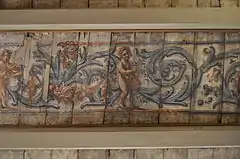Grimm 31
Grimm 31 was a Hamburg merchant's house on the island of Grimm in the center of Hamburg, Germany.
| Grimm 31 | |
|---|---|
 Part of the ceiling | |

| |
| General information | |
| Type | Hamburg merchant's house |
| Address | Grimm 31 |
| Town or city | Hamburg |
| Country | Germany |
| Completed | 16th Century |
| Destroyed | 1943 |
The house was built in the first half of the 16th century and destroyed in 1943 by bombs.
It is known mainly for its ornate wooden ceiling from the second half of the 17th century, which has been in the Hamburg History Museum since 1922. The ceiling was commissioned by the then owner, the merchant Christian Hasenbank.
The fully decorated pine ceiling was one of many examples in Hamburg merchant houses, but is probably the only 17th century example to remain accessible.[1] The painting is by an unknown artist on pine boards, 151 of which are still preserved. In the Hamburg Museum it is reconstructed on 17 joists with a further 68 boards added. The Baroque artwork includes putti and other figures in playful and bawdy acts. Within the image, there are several jokes: it shows Cain and Abel, referring to an old Hamburg saying, that "The Grimm" is the oldest street in the world, because according to the Bible, Cain slew Abel "im Grimm" ("in a rage").
The house's 1691 portal was typical of the houses in Grimm and Cremon. As with other houses from the late 17th Century, the portal and windows were almost equal elements of the facade. The portal itself was adorned with plant motifs and an angel's head. The mermaids, who also graced the portal, were probably the only ones of their kind in Hamburg.[2]
References
- Otto Lauffer: Museum für Hamburgische Geschichte, Bericht für das Jahr 1909, Hambur S. 318
- Hermann Heckmann: Barock und Rokoko in Hamburg, Verlag für Bauwesen, Berlin 1990 S. 51
- hamburgmuseum: Decken und Wanddekoration in Hamburg von Barock zum Klassizismus (Hamburg Porträt 28/97)